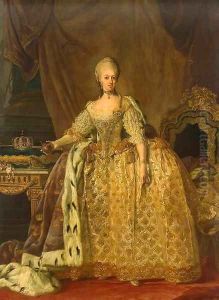Lorentz the Younger Pasch Paintings
Lorentz the Younger Pasch, born in 1739 in Stockholm, Sweden, was a notable figure in the world of art, particularly recognized for his contributions to 18th-century Swedish painting. He was part of a family deeply entrenched in the arts, which profoundly influenced his career path and development as an artist. His father, Lorentz Pasch the Elder, was a respected painter, and his sister, Ulrika Pasch, also became a well-regarded artist, indicating a familial environment rich in artistic talent and encouragement. This background provided him with a solid foundation in the arts from a very young age, enabling him to pursue a career that would leave a lasting impact on the Swedish art scene.
Pasch's education and artistic training were comprehensive, reflecting the conventions of the time, which emphasized mastery of both theory and practical skills. He embarked on his artistic journey under the watchful eye of his father, learning the craft's intricacies and developing a keen eye for detail. His talent and dedication to his craft soon led him to further his studies abroad, a common practice among artists of his era seeking to expand their horizons and gain exposure to different artistic styles and techniques. His travels took him to various parts of Europe, where he was exposed to the works of the great masters, enriching his artistic vocabulary and influencing his subsequent works.
Upon his return to Sweden, Pasch quickly established himself as a prominent portrait painter, sought after by the Swedish elite for his ability to capture not just the likeness but the essence of his subjects. His portraits are characterized by their elegance, attention to detail, and the subtle interplay of light and shadow, reflecting the influence of the European masters he studied under during his travels. Beyond portraiture, Pasch also engaged in historical and religious subjects, showcasing his versatility as an artist and his ability to imbue his works with emotional depth and narrative complexity.
Lorentz the Younger Pasch's contributions to Swedish art were not limited to his paintings. He played a significant role in the artistic community of his time, influencing the next generation of Swedish artists. His commitment to his craft and his ability to adapt and incorporate different artistic styles into his work helped pave the way for the evolution of Swedish painting in the late 18th and early 19th centuries. Pasch passed away in 1805, but his legacy lived on, not only through his own works but also through those of his students and the many artists he influenced throughout his career.
